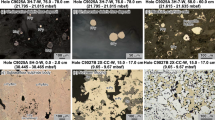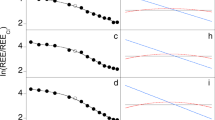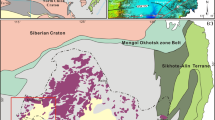Abstract
THE volcanogenic massive sulphide deposits of the Hokuroko district of Japan are Miocene metal occurrences which are rich in both Zn and Pb, contain minor Cu and yield noteworthy amounts of Ag and Au (ref. 1). They formed in the Green Tuff belt of Japan in association with the felsic calc-alkaline rocks of a back-arc spreading center1. Until now no modern analogue of this 'Kuroko' type of sulphide deposit has been identified; this is in contrast to the Cyprus type of massive Cu–Zn sulphide deposit, which has such an analogue in the 'smoker' deposits of the East Pacific Rise. In 1984 and 1986, low-temperature oxide and silicate precipitates were discovered in the rift valley of the Okinawa Trough attesting to the recent occurrence of hydrothermal activity in this intracontinental back-arc basin2. On 26 June 1988, a large hydrothermal field with extensive occurrences of sulphide mineralization (the Jade hydrothermal field) was discovered and sampled by the German research vessel Sonne in a cauldron in the central part of the Okinawa Trough. Here we report geochemical and isotopic results which suggest that the Jade deposit is a modern analogue of the Kuroko-type deposits known so far only from the geological record.
This is a preview of subscription content, access via your institution
Access options
Subscribe to this journal
Receive 51 print issues and online access
$199.00 per year
only $3.90 per issue
Buy this article
- Purchase on Springer Link
- Instant access to full article PDF
Prices may be subject to local taxes which are calculated during checkout
Similar content being viewed by others
References
Ohmoto, H. & Skinner, B. J. Econ. Geol. Monogr. 5, (1983).
Kimura, M. et al. Tectonophysics 145, 319–324 (1988).
Sibuet, J. C. et al. J. geophys. Res. 92, 14041–14063 (1987).
Halbach, P. et al. Tech. cruise Rep. SO 56 (Hydromin-project) prepared for the German Federal Ministry for Research and Technology, Clausthal-Zellerfeld (1989).
Yamano, M., Kinoshita, M. & Uyeda, S. Proc. Int. Symp. on Geothermal Energy Kumamoto-Beppu, Japan, 1–4 (1988).
Yamano, M., Uyeda, S. & Furukawa, Y. Bull. Earthquake Res. Inst. Univ. Tokyo 61, 311–327 (1986).
Nakamura, K. et al. Abstr. 4th Res. Symp. by the submersible “Shinkai 2000” Tokyo, 5–6 (1987).
Hessler, R. R. & Smithey, W. M. Jr in Hydrothermal Processes at Seafloor Spreading Centres (eds Rona, P. A., Bostrom, K., Laubier, L. & Smith, K. L.) 735–770 (Plenum, New York, 1983).
Barton, P. B. Jr Min. Geol. 28, 293–300 (1978).
Hannington, M. D., Peter, J. M. & Scott, S. D. Econ. Geol. 81, 1867–1883 (1986).
Hannington, M. D. & Scott, S. D. Econ. Geol. (submitted).
Arnold, M. & Sheppard, S. M. F. Earth planet. Sci. Lett. 56, 148–156 (1981).
Shanks, W. C. & Seyfried, W. E. Jr J. geophys. Res. 92, 11387–11399 (1987).
Kajiwara, Y., Sasaki, A. & Matsubaya, O., Geochem. J. 15, 193–197 (1981).
Oshima, S. et al. Rep. Hydrogr. Res. 24, 19–43 (1988).
Author information
Authors and Affiliations
Rights and permissions
About this article
Cite this article
Halbach, P., Nakamura, Ki., Wahsner, M. et al. Probable modern analogue of Kuroko-type massive sulphide deposits in the Okinawa Trough back-arc basin. Nature 338, 496–499 (1989). https://doi.org/10.1038/338496a0
Received:
Accepted:
Issue Date:
DOI: https://doi.org/10.1038/338496a0
This article is cited by
-
Magnesium isotopes of chlorite-rich hydrothermal sediments in the Okinawa Trough and indications for Mg cycle
Science China Earth Sciences (2023)
-
Sr isotopic ratios of hydrothermal fluids from the Okinawa Trough and the implications of variation in fluid–sediment interactions
Progress in Earth and Planetary Science (2022)
-
A Combination of Geostatistical Methods and Principal Components Analysis for Detection of Mineralized Zones in Seafloor Hydrothermal Systems
Natural Resources Research (2021)
-
Geochemical origin of methane in hydrothermal fluid and its implication for the subseafloor hydrothermal circulation at the Middle Okinawa Trough
Geo-Marine Letters (2021)
-
Mineralogy, geochemistry, and sulfur isotope characteristics of sediment-hosted hydrothermal sulfide minerals from the southern Okinawa Trough
Acta Oceanologica Sinica (2021)
Comments
By submitting a comment you agree to abide by our Terms and Community Guidelines. If you find something abusive or that does not comply with our terms or guidelines please flag it as inappropriate.



